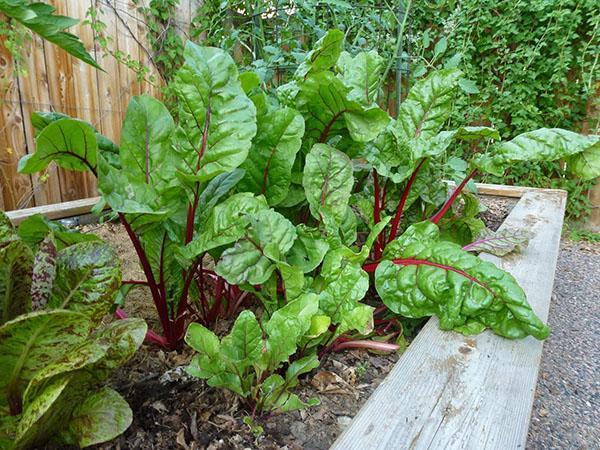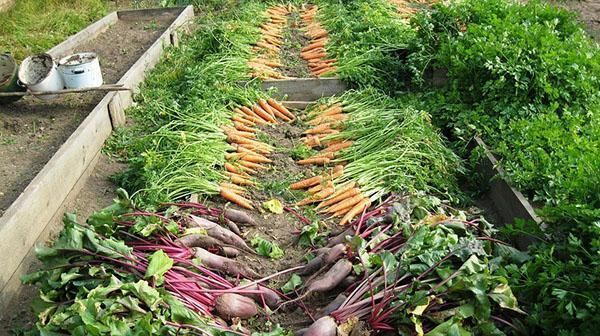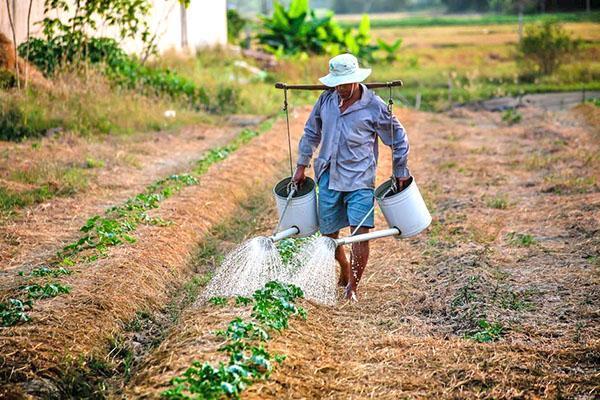We increase the yield of vegetable crops with warm beds
 Warm beds made with your own hands are a great opportunity to get a harvest earlier than usual. Our capricious Russian spring is often fraught with unpleasant surprises, for example, sharp drops in temperatures up to frost. In this article, we share our experience on creating warm beds for the purpose of growing vegetable products.
Warm beds made with your own hands are a great opportunity to get a harvest earlier than usual. Our capricious Russian spring is often fraught with unpleasant surprises, for example, sharp drops in temperatures up to frost. In this article, we share our experience on creating warm beds for the purpose of growing vegetable products.
Nikolai Kurdyumov, the famous agronomist and propagandist of natural agriculture, said that fertility is not a state, but a dynamic process that takes place in the soil. Warm layered beds are designed to create this continuous living process.
Vegetable crops develop much better on the living substrate of insulated beds, it is easier for them to cope with superficial night frosts, to endure temperature fluctuations. Vegetables on insulated ridges ripen faster, and the labor costs of summer residents are reduced.
Igor Lyadov's amazing garden

For many years in a row, Igor Lyadov's garden was in disrepair. Vegetable crops in the Far Eastern climate felt uncomfortable, they suffered from waterlogging, soaking.
Regular fertilizing with mineral fertilizers did not save the day, the taste of vegetables was unsatisfactory, potato degeneration was observed, and the yield of vegetable crops decreased every year.
The gardener enthusiast decided to take seriously his site. He noticed that when using wide traditional beds, only the leaves of those plants that were on the edges of the ridge develop normally.
The farmer concludes that the presence of fresh air masses and spaciousness affects the processes of plant growth and development. Igor Nikolaevich finds confirmation of his ideas in the method of growing vegetables by Mitlider. It boils down to growing crops on narrow strips of land with a fairly large row spacing (75 cm or more).
The Russian plant breeder decides to modify the technique and raise the warm, hand-made beds above the dirt paths by 20 cm in order to get rid of regular floods, which are not rare in the area where he lives. An enterprising gardener put together a wooden fence - a box, and fenced the ridges.
Such a fence served as protection against soil erosion. The result is an impromptu container.
 The advantages of containers are obvious:
The advantages of containers are obvious:
- the shape of the beds remains throughout the growing season;
- water is retained in the soil, and you can water the plants less often;
- a wooden box made it possible to more efficiently compost;
- high ridges prevent the loss of nutrients and carbon dioxide released by microorganisms.
Soon, Lyadov decides to abandon mineral fertilizers. Plants grown in his garden receive only organic matter in the form of manure, herbal infusion, compost, mulch. Also used wood ash... Igor Lyadov's warm beds and amazing vegetable garden are a great example of natural farming in the open field.
Beds in a greenhouse made of polycarbonate and polyethylene
 So that the plants do not suffer from return frosts, and also in order to accelerate their development, it is recommended to grow cucumber seedlings under a film cover until the last days of May. Before making the beds in the greenhouse, it must be thoroughly disinfected, remove last year's remains and replace damaged elements. In a small greenhouse, you can build three narrow beds, leaving two aisles for maintenance.
So that the plants do not suffer from return frosts, and also in order to accelerate their development, it is recommended to grow cucumber seedlings under a film cover until the last days of May. Before making the beds in the greenhouse, it must be thoroughly disinfected, remove last year's remains and replace damaged elements. In a small greenhouse, you can build three narrow beds, leaving two aisles for maintenance.
The materials for the construction of warm beds are used the same materials as for the beds in the garden. Insert all the necessary components into well-fixed boxes.
Plants feel much better on a warm bed under a reliable cover made of polycarbonate or polyethylene, they grow faster and painlessly endure nighttime cold snaps on the ground surface.
 If you want to get the first production of early cucumbers earlier, then you need to grow them through seedlings. When grown through seedlings, expensive or scarce seeds can be saved, each seed will yield a harvest and will not get lost in the soil.
If you want to get the first production of early cucumbers earlier, then you need to grow them through seedlings. When grown through seedlings, expensive or scarce seeds can be saved, each seed will yield a harvest and will not get lost in the soil.
Cucumber seedlings are planted in a permanent growing area when four true leaves appear on the plants.
Immediately before planting seedlings, pits are made on insulated high beds. The depth should be equal to the depth of the cup in which the cucumber seedlings were located.
On such ridges in an unheated greenhouse, cucumbers are planted in one row in the center of the ridge, leaving a distance of 20 cm between plants.
After a week, the plants must be tied to pegs, or better to a trellis. The lower edge of the rope is tied to a cucumber lash above the third leaf, 12 cm above ground level.
A warm bed with warming compost and manure under a polycarbonate cover or foil provides an optimal temperature regime for plants.
The temperature is regulated by ventilation, for this you can simply lift the plastic wrap or open the window.
A wooden box will keep moisture longer. Cucumbers are a vegetable that loves moisture very much. Before entering the fruiting period, it is necessary to water cucumber plantations every 2 to 3 days, while the water consumption per plant is 0.5 liters.
During the period of fruit ripening, cucumbers are watered daily, spending 1.5 - 3 liters of water for each root.
With the onset of stable heat, the covering material is completely removed.
Growing vegetables in warm beds in spring and autumn
 Modern greenhouses, even those built with their own skillful hands, are quite expensive for a summer resident, so zealous owners try to make the most of it.
Modern greenhouses, even those built with their own skillful hands, are quite expensive for a summer resident, so zealous owners try to make the most of it.
Even if the greenhouse is without additional heating, and you live in the country for a limited time, it is possible to develop such agricultural techniques so that the harvest ripens under transparent arches from April to November. Of course, this applies to stationary greenhouses, year-round covered with glass or polycarbonate.
In an unheated greenhouse, sowing of cold-resistant crops begins in early April, or at the end of March, if the weather is warm.
The seeds of radish, parsley, dill, lettuce, arugula, Chinese cabbage, mustard are the first to enter the ground.
No matter how the greenhouse protects, for early plantings it should be possible to additionally cover the plants with non-woven material.
Likewise, you can grow all of these crops in the fall, extending the season for the consumption of fresh herbs until the end of November.
Autumn harvest of greenery
 How to make a warm bed in the fall for growing greens by the end of November?
How to make a warm bed in the fall for growing greens by the end of November?
- At the end of August, the greenhouse is practically free of tomato plants, eggplant pepper, it is good if a couple of cucumber lashes are preserved. So why not use free areas, reliably covered from cold nights, for business use.
- As in early spring, thoroughly clean the greenhouse from plant debris, remove all damage, yellowed and diseased leaves from the remaining plants, rinse the polycarbonate surfaces.
- Loosen the soil, spill it with a dark red solution of potassium permanganate, fill with humus, wood ash and superphosphate.
- After a couple of days, water the prepared ridges with a phytosporin solution, make furrows and sow vegetables on greens.
A warm bed, built in an unheated greenhouse, will allow growing greens until the last days of November
Do-it-yourself warm beds, step by step production
 There is such a rule of the farmer: everything that is taken from the ground must be returned to it back:
There is such a rule of the farmer: everything that is taken from the ground must be returned to it back:
- Create compost pits on the site and fill them, adding some fertile soil, peat.
- Strictly follow the sandwich principle, that is, layers.
- In order for the compost heap to turn into a full-fledged compost, each row of waste must be covered with urea or other nitrogen fertilizers.
- One more condition: the compost must be watered, at least 15 buckets of water will have to be overturned per 1 square meter. And keep in mind that you need to pour water evenly, throughout the entire thickness of the heap. In the layer of compost and humus, earthworms will soon start, they will turn compost and humus into fertile humus.
 How to make a warm bed:
How to make a warm bed:
- It is necessary to knock down a box of boards that will enclose the garden bed, dig in a metal mesh around the perimeter of the box half a meter into the ground.
- Construct a drainage, lay compost on the intended place, cover with earth on top.
- From time to time it is necessary to sprinkle the surface of the beds with ash, this helps to protect the plantings from pests.

Tall, warm beds will save water for irrigation. It is recommended to mulch the ground with cut grass, slightly dried in the sun.
how to use a warm bed for the second and subsequent years
Like ordinary beds. On warm beds, you also need to follow the rules of crop rotation.